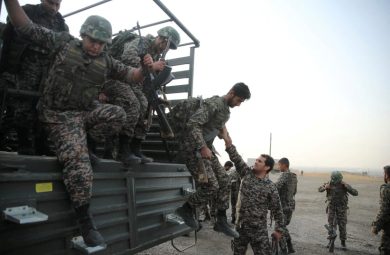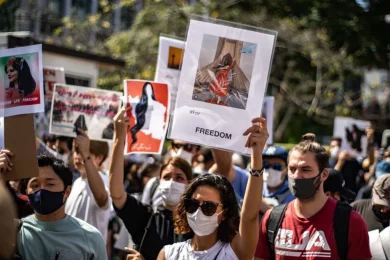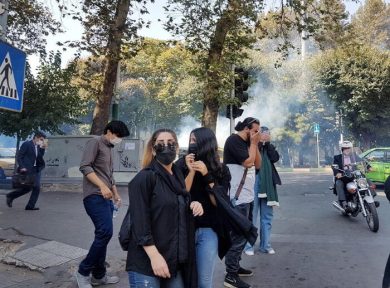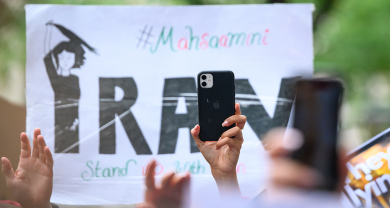The Islamic Revolutionary Guard Corps (IRGC), originally formed in 1979 to protect the principles of the Islamic Revolution in Iran, has evolved into the most powerful political, military, and economic institution in the country. Its reach extends beyond Iran’s borders through proxy militias, cyber warfare, and terrorist operations, and within the nation through systemic repression, censorship, and the violent silencing of dissent. This report investigates how the IRGC transformed from a revolutionary force into the core of Iran’s authoritarian structure.
1. Origins of the IRGC: Guardian of the Revolution
Following the 1979 revolution, Iran’s Supreme Leader Ayatollah Ruhollah Khomeini feared that the regular military, which had served under the Shah, might not be loyal to the new Islamic Republic. To protect the revolution, he ordered the creation of an ideological army — the IRGC.
The IRGC was designed with a dual mission:
• To safeguard the Islamic Revolution and its values.
• To act as a counterweight to the conventional military (Artesh).
Quickly, the IRGC became more than a security force. It developed into a state within a state — answerable only to the Supreme Leader.
2. Structural Power and Expansion
A. Military Capabilities
• The IRGC commands Iran’s ballistic missile program.
• Controls the elite Quds Force, responsible for operations abroad.
• Manages the Basij militia, a paramilitary force used for domestic suppression.
B. Political Influence
• Many former IRGC commanders hold key positions in Iran’s parliament, judiciary, and executive branch.
• It acts as the enforcer of the Supreme Leader’s authority, particularly during times of unrest.
C. Economic Empire
The IRGC runs a massive business empire, including:
• Construction (Khatam al-Anbiya)
• Telecommunications
• Oil, gas, and mining sectors
• Black-market trade and smuggling networks
Estimates suggest the IRGC controls 20–30% of Iran’s economy, giving it enormous leverage and autonomy.
3. The IRGC as a Repressive Domestic Force
A. Crushing Protests
The IRGC has violently suppressed every major uprising since the revolution:
• 1999 student protests
• 2009 Green Movement
• 2017–2018 economic protests
• 2019 fuel protests (with over 1,500 killed)
• 2022 Women, Life, Freedom movement
The IRGC deploys the Basij militia to intimidate, beat, and arrest protesters. They operate with impunity, often filming confessions under torture and broadcasting them on state TV.
B. Targeting Women and Minorities
• Women who defy mandatory hijab laws face arrest, surveillance, and torture.
• Ethnic minorities (Kurds, Baluch, Arabs) are disproportionately imprisoned, executed, and militarized by the IRGC.
• Religious minorities like Baháʼís are frequently persecuted and monitored.
C. Controlling Media and Free Speech
The IRGC controls much of the national media and uses its Cyber Defense Command to:
• Censor the internet
• Monitor online activity
• Track and arrest digital activists
• Spread disinformation and propaganda
4. IRGC’s Foreign Reach and Terrorism Designation
A. Exporting Violence
The IRGC’s Quds Force conducts extraterritorial operations including:
• Supporting Hezbollah in Lebanon
• Funding and arming militias in Iraq and Syria
• Backing Houthi rebels in Yemen
• Coordinating with Palestinian militant groups like Hamas and Islamic Jihad
These operations aim to extend Iran’s influence and challenge Western and regional rivals, particularly the United States, Israel, and Saudi Arabia.
B. Terrorist Designation
• In 2019, the United States officially designated the IRGC as a Foreign Terrorist Organization (FTO) — the first time a country’s military wing received this designation.
• Canada, Bahrain, and several other countries and entities have imposed sanctions against the IRGC or its branches, citing terrorism, human rights abuses, and regional destabilization.
5. The IRGC’s Role in Suppressing Women’s Rights
Women who protest compulsory hijab or gender discrimination are arrested by the morality police, often working under the guidance or protection of the IRGC and Basij.
Well-known cases include:
• Mahsa Amini, whose death in custody in 2022 triggered nationwide protests.
• Narges Mohammadi and Nasrin Sotoudeh, prominent women’s rights activists imprisoned for speaking out against gender apartheid.
The IRGC views gender equality as a threat to its ideological foundations and enforces patriarchal control through intimidation and violence.
6. Inside the IRGC’s Prisons
The IRGC oversees and influences the management of notorious prisons like:
• Evin Prison: Known for torture, solitary confinement, and execution of political prisoners.
• Qarchak Prison: Where women are subjected to inhumane treatment and often denied medical care.
Political prisoners held under IRGC orders are often:
• Denied legal representation
• Tortured for forced confessions
• Subject to mock trials with predetermined verdicts
7. Why the IRGC Remains Untouchable in Iran
A. Supreme Leader’s Protection
The IRGC is directly loyal to the Supreme Leader, not the government or the people. Its command structure bypasses civilian oversight entirely.
B. Fear and Intimidation
• The IRGC has the power to detain politicians, journalists, academics, and activists without due process.
• Its vast intelligence network prevents coordinated opposition from gaining traction.
C. Economic Self-Sufficiency
Its vast holdings allow the IRGC to operate outside the national budget, giving it autonomy even during times of economic crisis or sanctions.
8. International Responses and Limitations
Despite the IRGC’s record of abuse, many Western and regional governments have hesitated to fully confront the group due to:
• Fear of escalating tensions with Iran
• Economic interests, including nuclear negotiations
• Lack of coordinated global action
However, pressure is growing:
• Iranian diaspora movements are calling for IRGC designation as a terrorist organization in Europe.
• Human rights organizations are documenting the IRGC’s war crimes and abuses for potential international trials.
Conclusion
The IRGC is not just a military wing—it is the backbone of authoritarianism in Iran. From economic control to political repression, gender apartheid to regional warfare, the IRGC has embedded itself in every layer of Iran’s power structure.
Its evolution from a revolutionary force to a domestic and international enforcer has made it one of the most dangerous institutions in the region. For a free Iran to emerge, dismantling or severely restricting the IRGC’s influence will be essential.
Join Our Newsletter!
Stay informed with the latest updates, news, and ways to take action in the fight for justice and global security. Sign up now to get updates delivered straight to your inbox!





